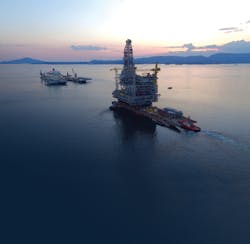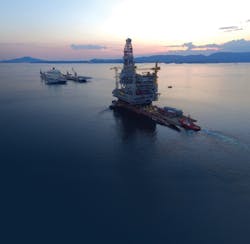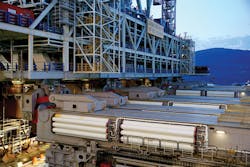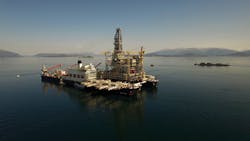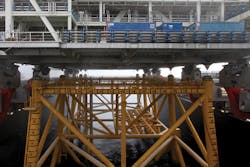Pioneering Spirit confirms prowess with first major topsides lift at Johan Sverdrup
Jeremy Beckman
Editor, Europe
Three-hour operation completed safely in thick fog
The $10.7-billion first phase of the Johan Sverdrup project in the Norwegian North Sea remains on track for start-up in late 2019. However, the timeframe – just over four years after final approval from Norway’s government – would not have been feasible without Allseas’ Pioneering Spirit speeding the offshore construction process. Earlier this summer, the 382-m (1,253-ft) long, 124-m (407-ft) wide vessel undertook its first-ever topsides installation, the 22,000-metric ton (24,251-ton) drilling platform, completing the world-record single-lift operation in only three hours. The vessel will return to the field complex next spring to set down the topsides for the two remaining Phase 1 platforms.
Project operator Equinor said the single-lift approach, as opposed to the standard multiple module lifts for giant platforms, had trimmed three months off the Phase 1 schedule and reduced the overall cost by around NOK1 billion ($124 million). But committing to a method unproven with topsides of this magnitude during Sverdrup’s planning phase had been a leap of faith for the company and its partners.
Moving the barge into the bow of the Pioneering Spirit.
(All photos courtesy Allseas)
When initial discussions started, the vessel was not even completed, and Aker Solutions had already delivered an outline modular design for all four platform topsides. According to Allseas President Edward Heerema, Equinor and all the Sverdrup partners were equally concerned about being the first to attempt a topsides installation in a single lift. Their main reservations were the accuracy of the vessel’s dynamic positioning system while alongside the pre-installed jackets; accurate positioning of the lifting yokes and monitoring of the vessel’s movements during lifting operations; and finally, positioning the topsides accurately and gently over the jacket base.
“During 2014 we held several meetings and presentations for Equinor’s partners,” Heerema said. “To support our case, we made an animation of how the vessel would work in operation (today this method is accepted and proven), and how the motion compensation system would achieve the required precision. We also produced computer simulations of how the lifting beams would function in practice.”
After winning unanimous approval from the partners, the next step was for Aker Solutions to make adaptations to three of the platform topsides that had been designed for modular lifts (the riser platform deck, being 10 m (33 ft) too long for Pioneering Spirit, would be installed in the traditional way). The main priorities were the need to strengthen the topsides’ underdecks with additional steel at concentrated lifting points and to ensure spreading of the load on the jacket. Allseas was tasked with engineering the eight lift points and stab-in cone requirements and designing and fabricating a total of 20 leg-mating units for the three installations.
“We also held regular meetings with the topsides fabricators Aibel and Samsung Heavy Industries to ensure that everything would come together well and would suit our method of installation,” Edward Heerema explained. “One of the main adjustments for the yards concerned was the need to adjust their construction process to build the topsides high up vertically. Because of the relatively late decision to build an integrated topsides structure for single-lifting, the topsides were first built modularly and only then put together.”
All yokes connected to the topsides.
Final readiness trials
When the Pioneering Spirit sailed into a fjord off western Norway in early June to collect the completed drilling topsides from Aibel, it had already demonstrated its lifting capability twice in the North Sea by removing the topsides from the Yme and Brent D platforms during late-summer 2016 and spring 2017, which weighed respectively 13,500 and 24,000 metric tons (14,881 and 26,455 tons).
Last summer the multi-purpose vessel switched for the first time to pipelay mode to install the first of the twin deepwater gas trunklines in the Black Sea for Gazprom’s TurkStream project and finished work on the first string at the end of April this year. The performance was consistently strong, Heerema said, with the vessel laying more than 5 km (3.1 mi) of pipe on certain days. But it was also important to complete the job on schedule, as Equinor’s contract – awarded long before the TurkStream assignment – had stipulated installation of the Johan Sverdrup drilling topsides during the early part of June. That timing was driven in part by the field construction schedule, but also by the assumption that weather conditions would be relatively benevolent for the vessel’s first major topsides installation.
Despite the success of the earlier topsides removals, Equinor had insisted on further trials of the vessel’s readiness for set-down operations. Allseas conducted the program at its test station at the K13 field in the Dutch North Sea in 2017 and during the latter part of this May, in the run-up to sailing to Norway.
Topsides seafastened ready for the voyage.
The test station, purpose-built for the initial Yme removal campaign, comprises a substructure (to simulate a jacket) and a 5,500-metric ton (6,063-ton) mock topsides. The final program was straightforward, Heerema said, the vessel conducting repeated lifts of the mock topsides with large water ballast tanks attached. “We wanted to go through the exercise of moving around the platform in DP mode, accurately positioning the load with the lifting yokes attached underneath, followed by lifting off the topsides, moving out, sailing in once again, then setting the topsides down. We repeated the whole sequence several times.”
Handover sequence
On arrival at the Bømlafjorden on Friday, June 1, the 147-m (482-ft) tall drilling topsides were transferred from a barge specially rented by Equinor to the Pioneering Spirit. The barge was of different dimensions to Allseas’ Iron Lady, which is designed specifically to fit within the U-shaped slot at Pioneering Spirit’s bows, and which the company used to offload the Yme and Brent D topsides. Following a few adjustments, the transfer process was completed within a few hours, mainly taken up with de-ballasting. The procedure was uncomplicated, helped by the fact that conditions in the fjord were calm.
Setting topsides down on the jacket.
As soon as the topsides were secure, the vessel sailed directly to the Johan Sverdrup field center 160 km (99 mi) west of Stavanger, an 11-hour voyage. On arrival, operations started immediately with the removal of the leg covers from the jacket which ensured clean receptacles for the topsides set-down points. According to Heerema, the action of setting down the topsides and ensuring mating to the jacket proved to be no more complicated than the prior topsides removals. “With old platforms it is a case of strengthening the lifting points, while a new platform is specially constructed in the first place to fit the single-lift principle. It’s basically the same process, although with Brent D, preparations for the lifting points took several months.” Nor was positioning the laden vessel alongside the Sverdrup drilling jacket technically more challenging than Yme or Brent, he added. “It’s the same procedure, but in reverse, and with experience, we get more confident.”
However, weather conditions on the day were much worse than expected, with thick fog leading to poor visibility. “As we approached we knew there was a platform very near that we could almost see, but not with sufficiently clarity and it required very careful maneuvering. We had various reference systems in operation to let us know that we weren’t swaying the vessel in the area of the platform, and we had people on the stern and bow to ensure the ship wouldn’t make any movement that might affect the platform. It was a big responsibility – the consequences of any impact could have been catastrophic, and therefore we took no chances with the accuracy of the positioning systems.”
For the lifting/set-down operation Allseas used eight yokes mounted on 16 horizontal lifting beams – two beams per lift point, similar to the arrangement for Brent D. No adjustments were needed to the vessel’s active motion compensation system: the initial lift at Yme had taken a little longer than normally envisaged because the air pressure system was not yet operating at its full capacity, due to the air valves not having been fully commissioned. But these issues had been fully resolved and the system’s full capability had been demonstrated during subsequent rougher-weather trials in late 2016.
Moving away from the platform.
Installation of the Johan Sverdrup drilling platform topsides was completed within three hours, from maneuvering around the jacket, to lowering the topsides into place, to finally withdrawing from the field center’s 500-m (1,640-ft) restricted zone. “We needed around 250 personnel for this operation working day and night shifts, and there were a total of 500 onboard, including many representative witnesses from Equinor and its partners,” Heerema said. “And at the same time, we were working on the foundation on the vessel’s port side for a new 5,000-metric ton (5,511-ton) crane that we have commissioned for conventional installation of lighter topsides and jackets, bridges and other structures.”
Next March Pioneering Spirit will return to a Norwegian fjord to pick up and install the 26,000-metric ton (28,660-ton) Johan Sverdrup process platform topsides and the 18,000-metric ton (19,842-ton) living quarter platform topsides. “For this first installation Equinor wanted the best possible conditions, but you have to expect rougher weather in March. However, the motion compensation system is designed to withstand a degree of roughness in the sea, and if we have to work in a few meters significant wave height, we will do that with confidence.”
By the end of 2019, a lifting system should also be in place to allow the vessel to install and remove large jackets weighing up to 20,000 metric tons (22,046 tons) – there will be plenty of these to extract from decommissioned North Sea fields over the next two decades. “We have placed the main order for the steel, wires and lifting hooks for the lifting system,” Heerema said, “and we’re also close to ordering the fabrication of the lifting beams.”
In mid-June the vessel returned to the Black Sea with its stinger fitted to resume laying Line 2 of TurkStream to the approach section close to Kiyikoy, Turkey. Future assignments include installation of the White Rose West topsides on a gravity base offshore Newfoundland for Husky Energy; the DolWin 6 transformer platform in the German North Sea; installation of the fifth platform at the Johan Sverdrup field center (in 2022) for the Phase 2 development; various removal programs; and laying of the twin Nord Stream 2 gas trunklines through the Baltic Sea.
Construction of the company’s next brainchild, the ultra-heavy lifting vessel Amazing Grace, could theoretically begin two years from now – “if we are completely satisfied about the design and the lifting system,” Heerema said, adding that successful experience with Pioneering Spirit to date had given the company more confidence to proceed with this project. The goal is to perform single-lifts of up to 72,000 metric tons (79,366 tons), 50% higher than Pioneering Spirit’s current capacity. •
How the topsides lifting/installation
system works
The vessel picks up topsides destined for offshore installation from a cargo barge in sheltered water, by using either “horseshoes” or support yokes, depending on the design of the underside of the topsides, mounted on the lifting beams. The configuration is adjusted to suit the dimensions of the structure. The horseshoes are closed around the topsides support legs while support yokes are positioned at pre-determined strong points on the structure’s underside.
The vessel then sails to the offshore installation location.
Before emplacement – possible in significant wave heights of up to 3.5 m (11.5 ft) – the vessel moves due to wave action, but all motions of the horseshoes or yokes relative to the platform are suppressed through engagement of the active motion compensation system.
Transfer from the vessel involves a rapid but gentle set-down – the reverse of the sequence of removing decommissioned topsides from a jacket – using hydraulic cylinders with a maximum stroke of 4 m (13 ft) in a matter of seconds.
